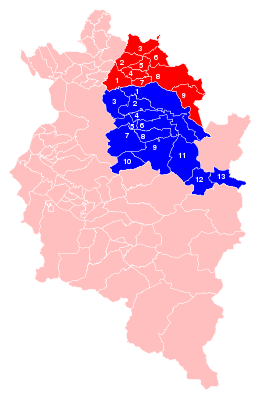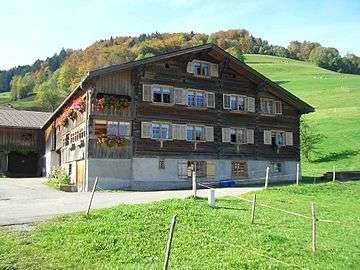Bregenz Forest
| Bregenz Forest | |
|---|---|
| Bregenzerwald | |
|
Damülser Mittagspitze, 2,095m | |
| Highest point | |
| Peak | Glatthorn |
| Elevation | 2,134 m (7,001 ft) |
| Coordinates | 47°15′56″N 9°52′48″E / 47.26556°N 9.88000°ECoordinates: 47°15′56″N 9°52′48″E / 47.26556°N 9.88000°E |
| Geography | |
 Bregenzerwald region within Austria
| |
| Country | Austria |
| States | Vorarlberg |
| Parent range | Northern Limestone Alps |
The Bregenz Forest (German: Bregenzerwald) is one of the main regions in the state of Vorarlberg, Austria. It overlaps, but is not conterminous with, the Bregenz Forest Mountains which are a range of the Northern Limestone Alps, specifically the northern flysch zone. It is the drainage basin of the Bregenzer Ach river.
Geography
The inhabitants often divide the Bregenz Forest into two main areas, the Vorderwald ("lower forest") and Hinterwald ("upper forest"). The Vorderwald, with its hills and low mountains, is closest to the Rhine valley. The Hinterwald has the higher mountains, with altitudes of up to 2,000 metres. Each of the two regions has its own distinctive dialect variations.
Villages

The principal villages in the Bregenz Forest are Bezau (the local capital), Alberschwende, and Egg. Alberschwende as a historic "Hofsteig" municipality did not used to be part of the Bregenz Forest region.
Lower Bregenz Forest (Vorderer Bregenzerwald) (red)
Upper Bregenz Forest (Hinterer Bregenzerwald) (blue)
Culture
Dialect
Until 1814, parts of the Allgäu belonged to Vorarlberg in the north and north-west. This and the fact that in the whole region due to the settlement by the Alemanni, the Lake Constance Alemannic dialect had predominated since the 5th/6th century, led, over the centuries, not only to a brisk trading of goods, but also to linguistic mingling as the result of an extended circle of marriages. Especially in the northwestern part of the Bregenz Forest (the Vorderwald or "Lower Forest") the influence of Allgäuerisch is particularly noticeable, the dialect strongly resembling the West Allgäuerisch dialect. By contrast, in the Middle and High Forest region the predominant language forms show a stronger connection with the region of Hofsteig and Dornbirn. From the outside, however, the forest dialect is perceived as an idiom (Wälderisch) which is not clearly distinguishable from the other Vorarlberg dialects (there is no uniform Vorarlbergisch dialect), despite this multi-layeredness and considerable local and regional variations.
Economy
The population of the Bregenz Forest earns a living from tourism, agriculture and trade that is strongly connected with the wood processing industry. Many locals also commute to work in the Rhine Valley, Vorarlberg's economic centre. The "Werkraum Bregenzerwald"[1] is a coalition of trade and industry in the region, which also holds the design competition "Handwerk+Form"[2] ("craft + shape") every three years.
In spring 2011, the three-level agricultural structure of the Bregenz Forest, also known as Alpine transhumance, was included in the Austrian list of cultural landscape candidates for recognition by UNESCO. The proposal recognises that the Bregenz Forest is "an impressive landscape on the north side of the Alps" that has "largely maintained its traditional farming structure". These include linear or nucleated villages, characteristic of the region, with farmsteads dating back to the 18th and 19th centuries. In addition, there are many small craft workshops amongst the farming community. Singled out for particular mention are the villages of Thal, Schwarzenberg and Schoppernau, with their fine examples of original Bregenz Forest houses ("Wälderhäuser").[3]
Tourism
The Bregenz Forest is best known as a skiing location, but other attractions include the "Käsestraße" and the "Schubertiade" festival of classical music in Schwarzenberg. The Bregenz Forest attracts those in search of unspoiled nature, old traditions and genuine hospitality.
The Bregenz Forest is particularly well known amongst gourmets for the "KäseStrasse Bregenzerwald",[4] an association of farmers, restaurateurs, craftspeople and traders promoting the Bregenz Forest agriculture and its local products, especially (but not exclusively) cheese. In particular, Bregenz Forest Mountain Cheese ("Bregenzerwälder Bergkäse") is an internationally renowned speciality.
The Bregenz Forest Railway ("Bregenzerwaldbahn" or, colloquially, "’s Wälderbähnle") is another attraction of the region. It is a museum railway that operates on a surviving section of a narrow gauge railway. From 1902 to 1983, the "Wälderbähnle" worked a line stretching 35.5 kilometres (22 mi) from Bregenz to Bezau. In October 2004, a section of 6.1 km (3.7 mi) was usable, but part of it was lost to a road expansion project, leaving just 5 km (3.1 mi) available.
In 2000, the Women's Museum opened in Hittisau, the only one of its kind in Austria.[5] The museum is devoted to the display and documentation of the cultural works and (his)stories of women, dealing with questions of female identities and gender roles.[6]
Another museum in the Bregenz Forest is the Angelica Kauffman Museum[7] in Schwarzenberg. The museum is dedicated to the baroque artist Angelica Kauffman, and has an Austrian museum seal of quality.
The region is also popular for its hiking and cycling trails as well as numerous ski areas.
Gallery
References
- ↑ Werkraum Bregenzerwald (in German)
- ↑ Handwerk+Form (in German)
- ↑ "Bregenzerwald (Bregenz Forest)" at whc.unesco.org. Accessed on 13 Mar 2013.
- ↑ KäseStrasse Bregenzerwald (in German)
- ↑ Frauenmuseum Hittisau accessed on 6 September 2011
- ↑ Frauenmuseum Hittisau - Konzept (in German)
- ↑ Angelika Kauffmann Museum accessed on 6 September 2011
External links
| Wikimedia Commons has media related to Bregenz Foerst. |
- http://www.bregenzerwald.at - Tourist website
